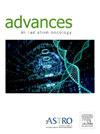Improved Efficacy of a Predictive Model for Swallowing-Induced Breakthrough Pain Based on a Redefined Delineation Method in Locally Advanced Nasopharyngeal Carcinoma
IF 2.2
Q3 ONCOLOGY
引用次数: 0
Abstract
Purpose
The objective of this study was to explore the performance of a predictive model for swallowing-induced breakthrough pain established using a redefined delineation method based on the common occurrence sites of radiation-induced oral mucositis (RIOM) in locally advanced nasopharyngeal carcinoma (NPC).
Methods and Materials
A total of 208 patients with locally advanced NPC were included in the study cohort, and the test cohort consisted of 88 patients. The oral mucosa structure was contoured using oral cavity contour (OCC), mucosal surface contour (MSC), and oral-pharyngeal mucosa (OPM) methods, and relevant dosimetric parameters were collected. Assessment of the severity of RIOM was made with the National Cancer Institute's Common Terminology Criteria for Adverse Events, version 4.0. The random forest classification method was chosen to establish and validate the predictive models based on 3 contouring methods.
Results
The area under the curve of the OPM-based model was higher than that of the OCC- and MSC-based models in both the validation cohort and the test cohort (0.800, 0.739, and 0.750; 0.670, 0.605, and 0.609, respectively). Better predictive performance could also be observed under the OPM method than the OCC and MSC methods in terms of accuracy. The OPM-based model showed high specificity (greater than 90%) in both the validation cohort and the test cohort. According to the mean decrease in the Gini index, the maximum dose was the most important predictor of severe oral mucositis in the OPM-based model.
Conclusions
We redefined a delineation method for oral mucosa structure based on the common occurrence sites of RIOM in locally advanced NPC. The model for swallowing-induced breakthrough pain constructed based on this method demonstrated good predictive performance. New parameters were found as predictors of severe swallowing-induced breakthrough pain in locally advanced NPC.
局部晚期鼻咽癌中基于重新定义划定方法的吞咽诱发突破性疼痛预测模型的疗效改进。
目的:本研究的目的是探讨基于局部晚期鼻咽癌(NPC)放射性口腔黏膜炎(RIOM)常见发生部位的重新定义划定方法建立的吞咽性突破性疼痛预测模型的性能。方法与材料:研究队列共纳入208例局部晚期鼻咽癌患者,试验队列共88例患者。采用口腔轮廓(OCC)、粘膜表面轮廓(MSC)和口咽粘膜(OPM)法对口腔黏膜结构进行轮廓,并收集相关剂量学参数。RIOM的严重程度评估是根据国家癌症研究所不良事件通用术语标准4.0版进行的。选择随机森林分类方法建立并验证基于3种轮廓法的预测模型。结果:在验证队列和检验队列中,基于opm的模型曲线下面积均高于基于OCC和msc的模型(0.800、0.739和0.750;分别为0.670、0.605和0.609)。在精度方面,OPM方法的预测性能也优于OCC和MSC方法。基于opm的模型在验证队列和测试队列中都显示出高特异性(大于90%)。根据基尼指数的平均下降,在基于opm的模型中,最大剂量是严重口腔黏膜炎的最重要预测因子。结论:我们根据局部晚期鼻咽癌RIOM的常见发生部位,重新定义了口腔黏膜结构的圈定方法。基于该方法构建的吞咽诱发突破痛模型具有较好的预测效果。发现了新的参数作为局部晚期鼻咽癌严重吞咽诱发突破性疼痛的预测指标。
本文章由计算机程序翻译,如有差异,请以英文原文为准。
求助全文
约1分钟内获得全文
求助全文
来源期刊

Advances in Radiation Oncology
Medicine-Radiology, Nuclear Medicine and Imaging
CiteScore
4.60
自引率
4.30%
发文量
208
审稿时长
98 days
期刊介绍:
The purpose of Advances is to provide information for clinicians who use radiation therapy by publishing: Clinical trial reports and reanalyses. Basic science original reports. Manuscripts examining health services research, comparative and cost effectiveness research, and systematic reviews. Case reports documenting unusual problems and solutions. High quality multi and single institutional series, as well as other novel retrospective hypothesis generating series. Timely critical reviews on important topics in radiation oncology, such as side effects. Articles reporting the natural history of disease and patterns of failure, particularly as they relate to treatment volume delineation. Articles on safety and quality in radiation therapy. Essays on clinical experience. Articles on practice transformation in radiation oncology, in particular: Aspects of health policy that may impact the future practice of radiation oncology. How information technology, such as data analytics and systems innovations, will change radiation oncology practice. Articles on imaging as they relate to radiation therapy treatment.
 求助内容:
求助内容: 应助结果提醒方式:
应助结果提醒方式:


